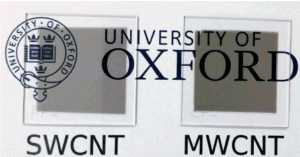Novel method for obtaining conductive films

Carbon nanotubes (CNTs) have attracted a lot of attention for their potential use in electronic and energy-related devices. In particular, conductive carbon nanotube (CNT) films are expected to be applied in anti-static materials, electromagnetic interference (EMI) shielding materials and other opto-electronic devices like solar cells. Poor solubility of CNTs in organic and aqueous solvents has, so far, been overcome with non-covalent wrapping with conjugated polymers, but at a high cost.
Oxford researchers have developed a novel method for obtaining conductive CNT films with inexpensive, non-conjugated polymers. These films show high transparency and similar conductivities to previous conductive CNT films using conjugated polymers. This novel method produces very inexpensive conductive CNT films.
Conductive CNT films
Conductive coatings are widely used for electromagnetic interference shielding applications, anti-static material and other opto electronic devices. The global conductive coatings market was valued at $15,120 million in 2016 and is projected to reach at $24,360 million by 2023, growing at a CAGR of 6.8% from 2017 to 2023 (Allied Market Research).
The most commonly used materials are metal nanoparticles or carbon black where transparency is not a requirement, or conductive oxides and conductive polymers when a transparent coating is required. Materials such as CNTs are projected to make a big breakthrough in the field.
The problem with cost
Generally, conductive CNT films show high conductivity and good mechanical properties but are expensive to produce. One of the reasons is that using non covalent wrapping with expensive conjugated (semi-conducting) polymers are thought to be essential due to the poor solubility of CNTs in organic and aqueous solvents. In order to overcome this high cost, an innovative method of obtaining conductive CNT films without using expensive conjugated polymers is highly desired.
CNT functionalisation with non-conjugated polymers
Researchers at the University of Oxford have found a novel method of obtaining semi-transparent conductive films. This has been achieved with inexpensive stable non-conjugated polymers. These films show high transparency and similar conductivities to previous conductive CNT films that use conjugated polymers.
Using this method, conductive films can be directly produced from solution or sprayed onto any surface.
The main advantages of the Oxford method are:
- Similar conductivity but lower cost than previous CNT conductive films using conjugated polymer
- Better environmental stability of non-conjugated polymer than used conjugated polymer
- Can be directly sprayed onto any surface
Patent protection
A patent has been filed which covers this technology. Oxford University Innovation is interested in talking to potential partners to aid in the commercialisation of this new method.
about this technology

